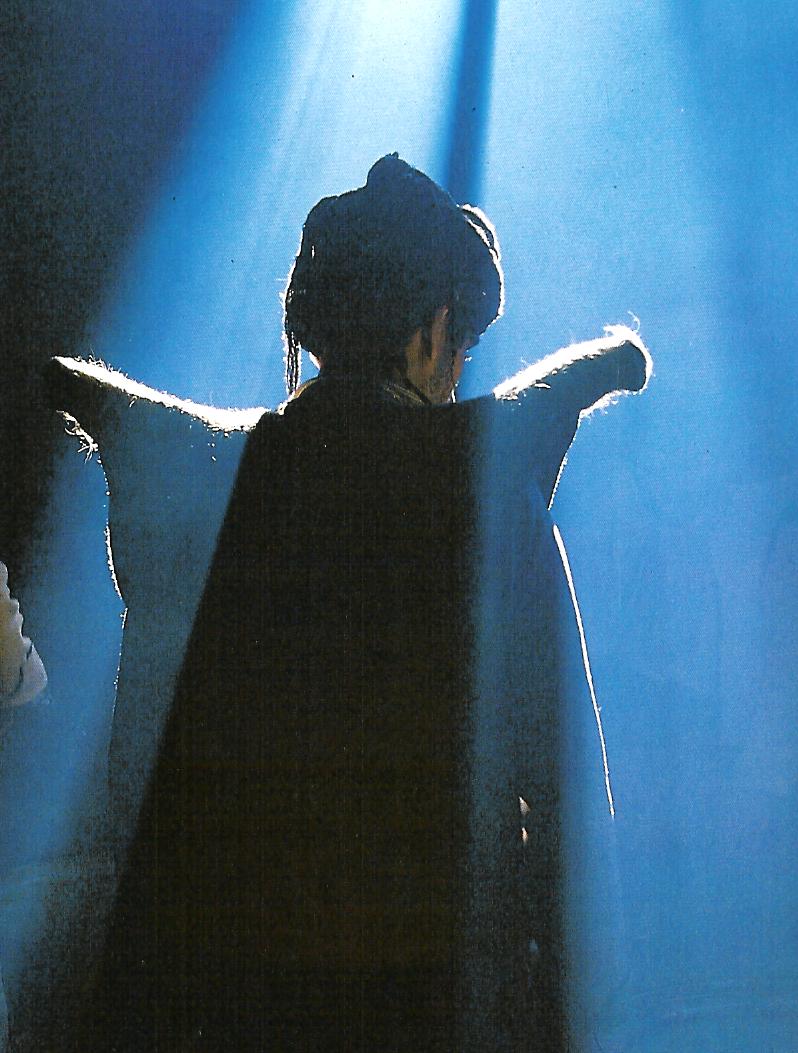The article below “A History of the worship of Mithras, and Mithraism as a Mystery Religion” was originally published in the mithraeum.info website. Kindly note that the images and accompanying inserted below do not appear in the original article posting in the mithraeum.info website.
==================================
Mithraism is the worship of the god Mithras, best known as an ancient Roman Mystery Religion. Mithras is the Roman name for the Indo-Iranian deity Mitra or Mithra, and it is by that name that he was known the Persians. Mithra was one of the minor deities under Ahura-Mazda in the Zoroastrian pantheon, from 1,500 BCE onward. Since the beginning, Mithra, or Mithras has been associated with the Light of the Sun, Truthfulness, and Mediation.
Roman worship of Mithras began sometime during the 1st century CE and continued to the end of the 4th Century CE. During this time the worship of Mithras spread throughout the ancient world. Mithraeums, Roman temples of the Mithraic Mysteries, are found in almost every ancient European country; Britain, Spain, Germany and the rest of Western and Eastern Europe, and even into Aftrica. It is believed that the Romans first encountered the worship of Mithras within the religion of Zoroastrianism in the Eastern provinces of the Empire, near the Persian border. There are various theories as to the beginnings of Roman Mithraism, and exactly how much Persian information was incorporated in the Roman Mysteries. Today most of what is known about Mithrasim comes from archaeological remains from Mithraeums, dedicatory inscriptions, iconography, and a small amount of literary evidence from the Classical world.
Aspects of Mithras the God
Mitra, or Mithra is the Indo-Iranian name for the Roman god Mithras. Mitra is known from the ancient Hindu pantheon, and Mithra is a name known from the Zoroastrian pantheon. In Zoroastrianism, Mithra is one of the “yazatas”, or minor deities under Ahura-Mazda. In Zoroastrianism Mithra is a god of Light that mediates between heaven and earth. Mithra also presides over honorable contracts and mediation.
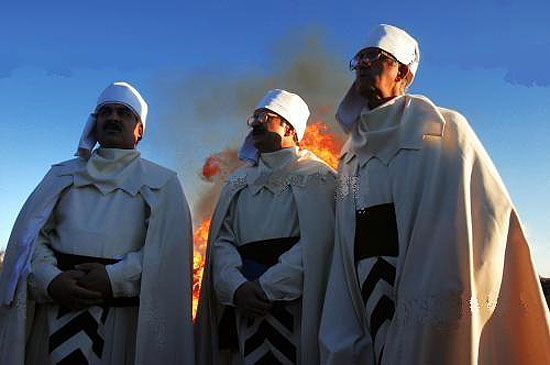
Zoroastrian magi from Kerman during the Jashne Sadeh ceremonies (Source: Heritage Institute).
Mithras is mentioned both in the Vedas, the ancient holy books of Hindusim, and he is also named in the hymns of the Zoroastrian Avesta, which was written between 224-640 CE as a compilation of older religious oral traditions.
The Mysteries of Mithras
The Roman cult of Mithras is known as a “mystery cult.” A Mystery Cult is an organized, secret system of learning and worship through which participants undergo ritual ritual initiations to confirm various stages of knowledge and inner development. Worship took place in a temple, called a mithraeum, which was made to resemble a natural cave. Sometimes temples were built specifically for the purpose, but often they were single rooms in larger buildings which usually had another purpose (for example, a bath house, or a private home). There are over a hundred mithraea preserved in the empire. Mithraea were longer than they were wide, usually around 10-12m long and 4-6m wide, and were entered from one of the short sides. Roman dining couches, called klinai or podia, lined the long sides of the mithraeum, leaving a narrow aisle in between. At the end of this aisle, opposite the entrance, was the Tauroctony, the cult image showing Mithras sacrificing a bull. The ceiling of the mithraeum was often painted with stars to symbolize the dome of heaven, or the cosmos.
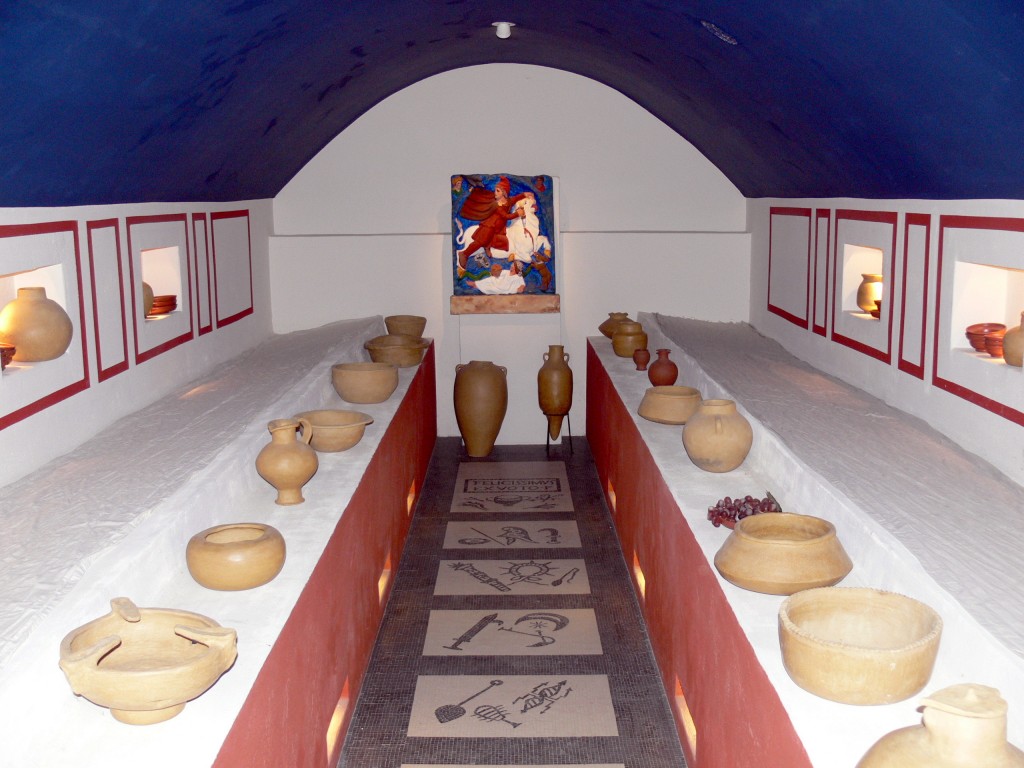
A reconstruction of a Mithraeum (Darb-e Mehr) depicting the stages of ascension on the floor as alluded to in the previous photo this posting (Source:Wolfgang Sauber for Public Domain). Note the placing of grapes (right side); grapes continue to signify vitality and renewal in Iran, Italy, Anatolia and the Caucasus.
Very little Mithraic liturgical text has survived, but much is known from temple imagery and inscription. It is known that in certain rites mithraists gathered for a common meal, initiation of members, and other ceremonies. It is also known that the structure of Mithraism was hierarchical. Members went through a series of seven grades, each of which had a special symbol and a ruling planet. From lowest to highest these grades were Corax (raven, under Mercury), Nymphus (a made-up word meaning male bride, under Venus), Miles (the soldier, under Mars), Leo (the lion, under Jupiter), Perses (the Persian, under Luna, the moon), Heliodromus (Sun-Runner, under the sun), and finally Pater (father, under Saturn). Those who reached the highest grade, Pater, could become the head of a congregation. Because mithraea were so small, new congregations were probably founded on a regular basis when one or more members reached the highest grade. It is known that it was possible for Mithraic initiates to be members of more than one cult, as inscriptions from various Mithraists have shown.

Click to Enlarge] The stages of Roman Mithraism: Stage 1: Cerax (Raven); – Stage 2-Nymphos (Bride); Stage 3-Miles (Soldier); Stage 4-Leo (Lion); Stage 5-Perses (Persian); Stage 6- Heliodrommus (Sun-Runner); Stage 7-Pater (Father) (Picture sources: Hinnels, 1988). Note that term “Bride” often used to denote “Nymphos” for the second stage is simplistic at best. The Latin term should actually be in the feminine “Nymphe” and not the masculine “Nymphos” or a male bride which possibly may suggest something of a mystical male-female fusion. The reasons for this are not as yet clear, but it seems consistent with Roman or Western (as opposed to the original Iranian) Mithraism which is believed to have excluded women from its rituals and membership. Note that in the final grade (Stage VII-Father) there is a distinct Persian cap symbolizing the cap of Mithras (Picture sources: Cerax, Nymphos, Miles from Hinnels, 1985; Leo, Persian, and Heliodrommus, and Pater in Public Domain).
Mithraic Iconography
There is a rich and cohesive body of iconography which has survived within the various Mithraeum temples. Central to each mithraeum there was the tauroctony, the image of the bull slaying which was shown at the main altar. In the tauroctony Mithras is clad in a tunic, trousers, cloak, and a pointed cap usually called a Phrygian cap. He looks away from the bull while half-straddling its back, and pulling the bull’s head back by its nostrils with his left hand. Mithras is plunging a dagger into the bull’s shoulder with his right hand. Various figures surround this dramatic event. Under the bull a dog laps at the blood dripping from the wound and a scorpion attacks the bull’s testicles. Often the bull’s tail ends in wheat ears and a raven is perched on the bull’s back. The scene is bracketed at the sides by the two smaller figures of Cautes and Cautopates, both of whom wear costume similar to that of Mithras. Cautes is to the right, holding an upraised and burning torch. Above him, in the upper left corner, is the sun god, Sol, in his chariot. On the viewer’s left there is Cautopates, who holds a torch that points downards and is sometimes, but not always, burning. Above Cautopates in the upper right corner is the moon, Luna. This group of figures is almost always present, but there are variations, of which the most common is an added line of the signs of the zodiac over the top of the bull-sacrificing scene.
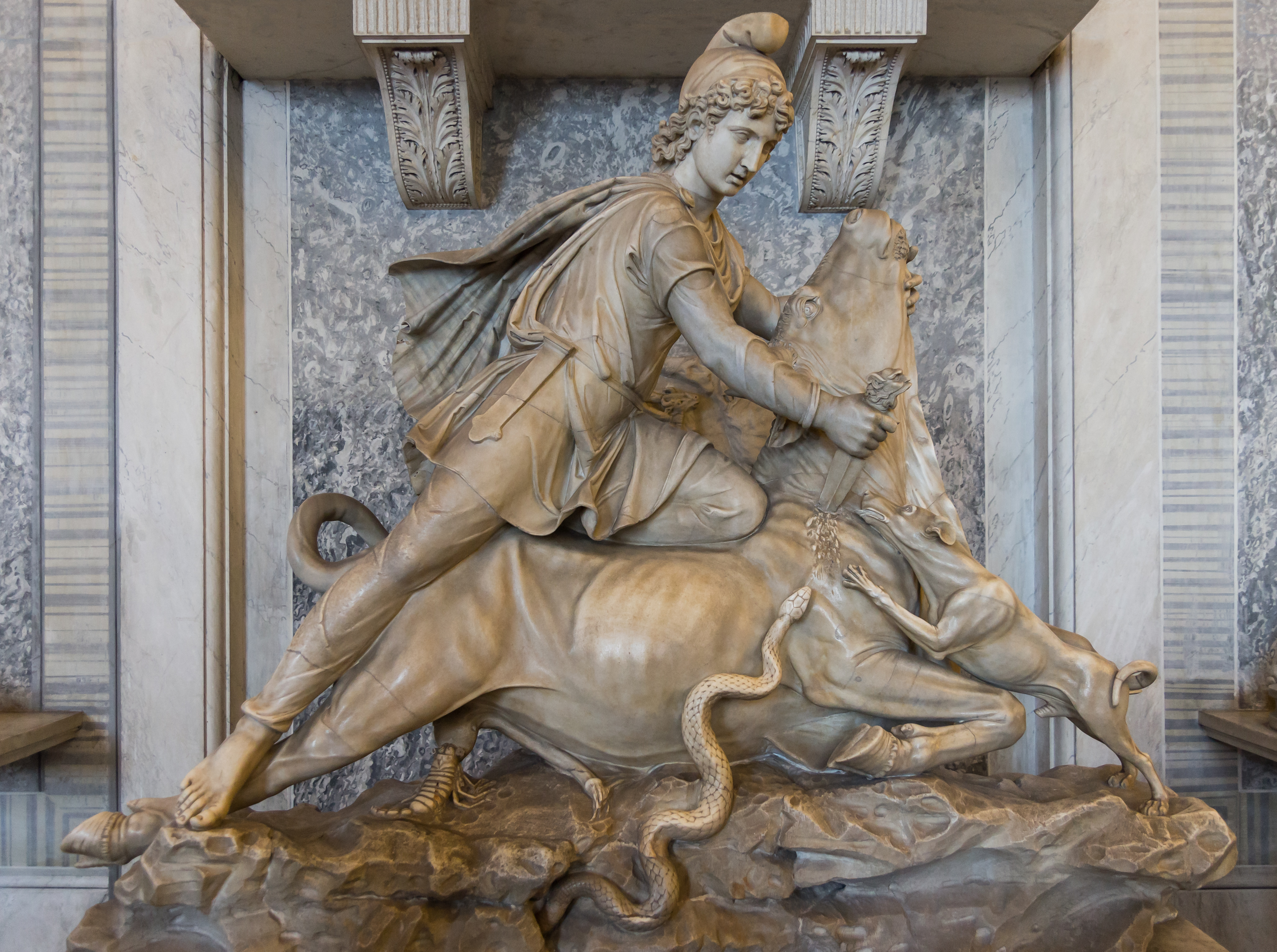
Another depiction of Mithras with Persian dress slaying the sacred bull at the Vatican Museum in Rome (Source: Eskipaper.com). Note the dog and serpent heading towards the gushing blood pouring down from the bull’s neck as the the scorpion heads towards the dying bull’s testicles.
In addition to this central scene there can be numerous smaller scenes which seem to represent episodes from Mithras’ life. The most common scenes show Mithras being born from a rock, Mithras dragging the bull to a cave, plants springing from the blood and semen of the sacrificed bull, Mithras and the sun god, Sol, banqueting on the flesh of the bull while sitting on its skin, Sol investing Mithras with the power of the sun, and Mithras and Sol shaking hands over a burning altar, among others. These scenes are the basis for knowledge of mithraic cosmology. There is no supporting textual evidence.
Mithraism and the Ancient World
The archaeological evidence for Mithraism, consisting mostly of monuments, inscribed dedications, and the remains of mithraea, indicates that the cult was widely practiced among the Roman Legions legions stationed in frontier areas. The Danube and Rhine river frontier has the highest concentration of evidence, but a significant quantity of evidence amply demonstrates that Mithraism was also popular among the troops stationed in the province of Numidia in North Africa and along Hadrian’s wall in England. The inscriptions on dedications found in all these areas show s Mithraism was most popular among legionaries (of all ranks), government officials, and even also merchants and even slaves.
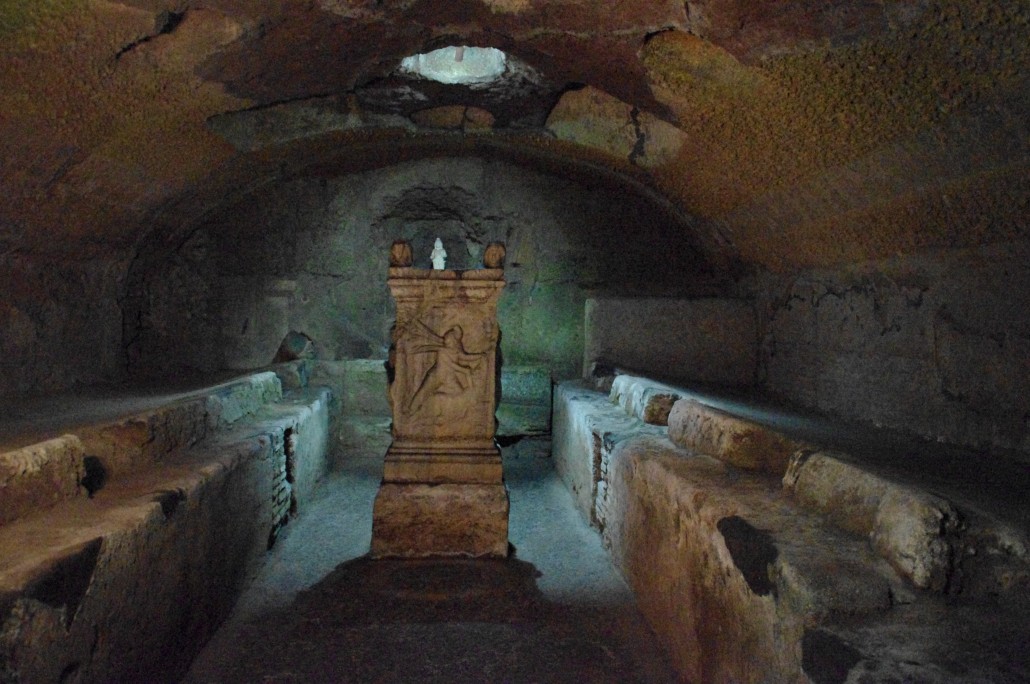
The Mithraeum located under Rome’s Basilica of San Clemente (Source: Public Domain).
The area where the concentration of evidence for Mithraism is the most dense is the capital, Rome, and her port city, Ostia. There are eight extant mithraea in Rome of as many as seven hundred (Coarelli 1979) and eighteen in Ostia. In addition to the actual mithraea, there are approximately three hundred other mithraic monuments from Rome and about one hundred from Ostia. This body of evidence reveals that Mithraism in Rome and Ostia originally appealed to the same social strata as it did in the frontier regions. The evidence also indicates that at least some inhabitants knew about Mithraism as early as the late first century CE, but that the cult did not enjoy a wide membership in either location until the middle of the second century CE.
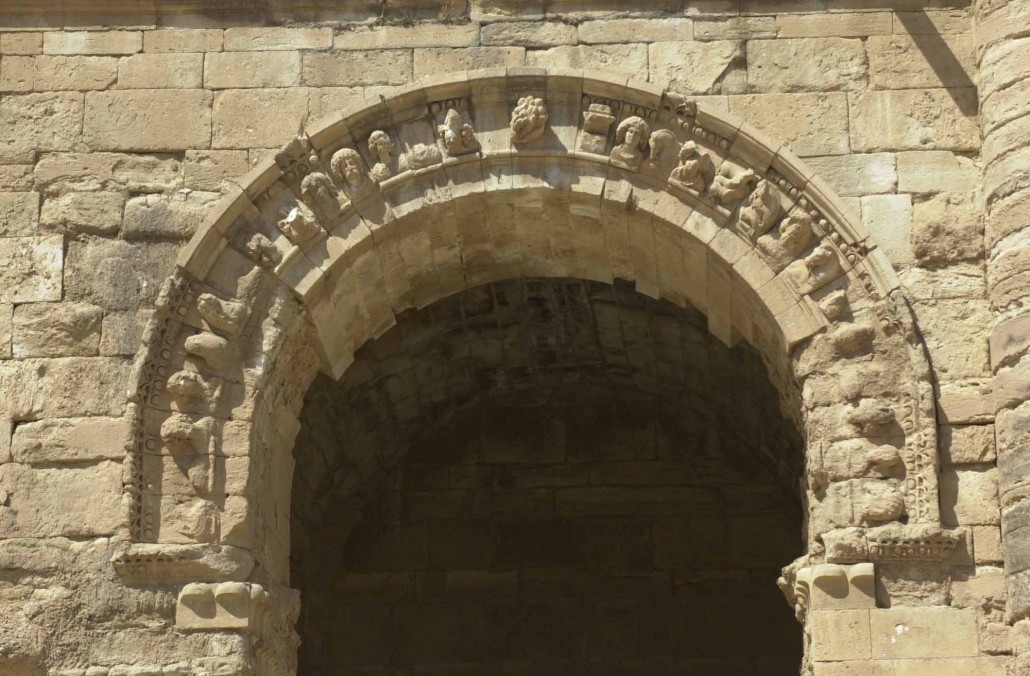
Entrance to the Temple of Hatra in Iraq, possibly dedicated to Mithras (Source: Public Domain).
As the cult in Rome became more popular, it seems to have “trickled up” the social ladder, with the result that Mithraism could count several senators from prominent aristocratic families among its adherents by the fourth century CE. Some of these men were initiates in several cults imported from the eastern empire (including those of Magna Mater and Attis, Isis, Serapis, Jupiter Dolichenus, Hecate, and Liber Pater, among others), and most had held priesthoods in official Roman cults. The devotion of these men to Mithraism reflects a fourth-century “resurgence of paganism,” when many of these imported cults and even official Roman state religion experienced a surge in popularity although, and perhaps because, their very existence was increasingly threatened by the rapid spread of Christianity after the conversion of the emperor Constantine in 313 CE.
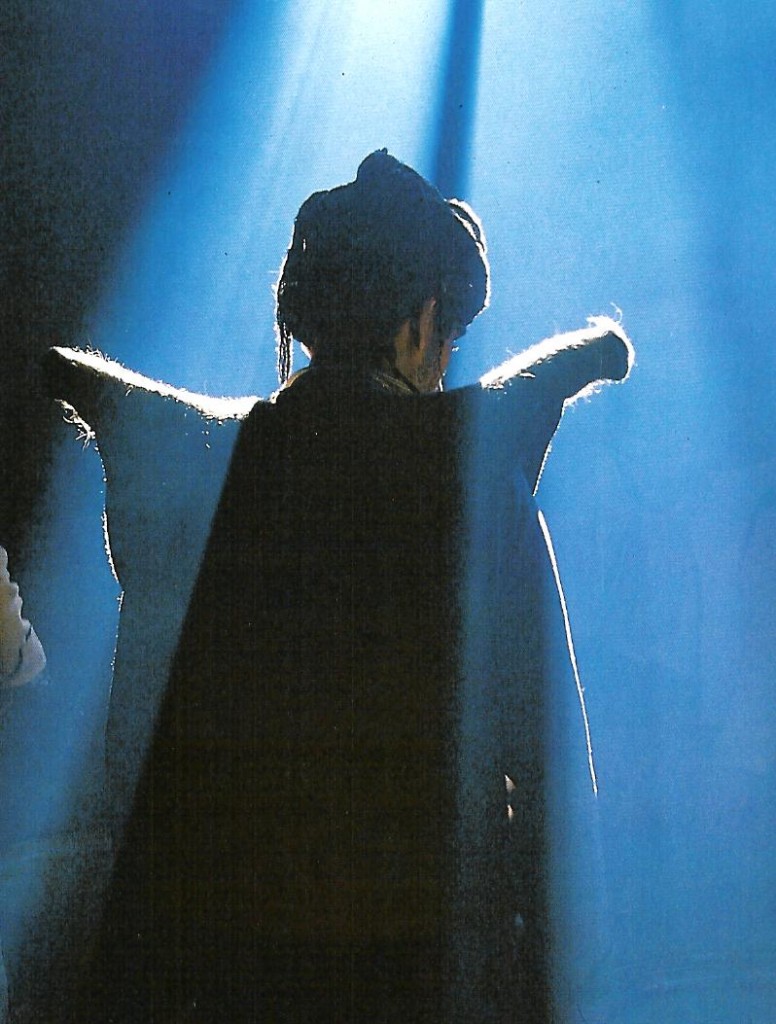
Kurdish man engaged in the worship of Mithras in a Pir’s (mystical leader/master) sanctuary which acts as a Mithraic temple (Source: Kasraian & Arshi, 1993, Plate 80). Note how he stands below an opening allowing for the “shining of the light”, almost exactly as seen with the statue in Ostia, Italy. These particular Kurds are said to pay homage to Mithras three times a day.
Mithraism had a wide following from the middle of the second century to the late fourth century CE. Although Christianity and Mithraism were rival cults Mithraism was at a serious disadvantage right from the start because it allowed only male initiates. What is more, Mithraism was only one of several cults imported from the eastern empire that enjoyed a large membership in Rome and elsewhere. It was these groups as a combined whole that were the greatest competition to Christianity.
The End of Ancient Mithraism
Mithraism as an organized religion seems to have been in trouble almost immediately after about 313 CE, when the Emperor Constantine converted to Christianity. The power centers of Mithraism were in Rome, the area closest to the newly Christian state. A great number of its adherents were part of the government and the Legions. In order to maintain the good graces of the Emperor many Mithraists seem to have left or even turned against the worship of Mithras. From this time onward there is archaeological evidence of Mithraeums being abandoned and even desecrated and destroyed. This was certainly encouraged by the early Church. Christians saw Mithraism as a devilish imitation of what they believed to be the one true religion, and they frequently broke into and destroyed Mithraic temples with “official” approval.
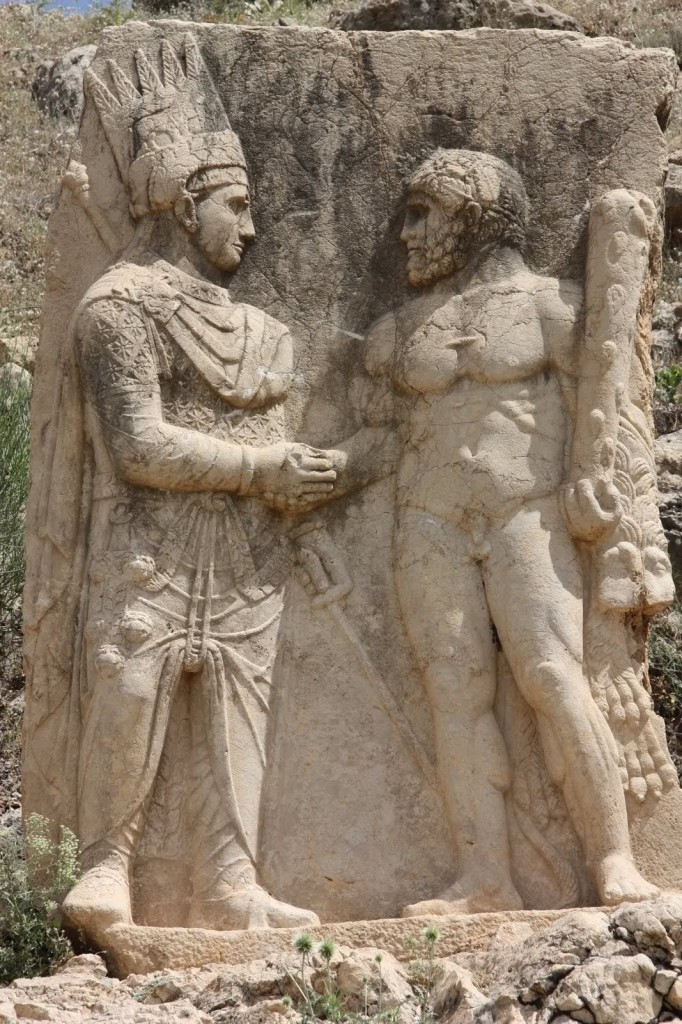
An interesting relief at the ruins of Arsameia, the capital of the kingdom of Commagene in 1st century BC. King Mithradates I Kallinikos of Commagene (100–70 BC) dressed as the Zoroastrian Magi (left) shakes hands with the Greek god Hercules (Source:Kaveh Farrokh’s lectures at The University of British Columbia’s Continuing Studies Division; Photo originally by Mani Moradi). Note that Hercules in Commagene also represented the Persian god Artagnes. Commagene like the Pontus was a small post-Achaemenid Iranian kingdom in Anatolia situated squeezed between Parthia to its east and the expanding Roman Empire to its west. Various versions of Mithradates’ crown continue to appear among various mystical sects of Western Iran, notably Kurdistan.
Although evidence is not conclusive it is thought that Mithraism may have lacked a clear and cohesive organization and hierarchy between individual groups, as Christianity was to have later. If this is the case, then an already depleted Mithraic cult must have found it difficult indeed to stem a rising tide of official opposition. Individual Mithraeums and groups seem to have fallen one by one without a system of mutual support.
The last known archaeological dating from a Mithraeum is from 408 CE. It is entirely possible that pockets of Mithraism survived later than that, but it is certain that there was in essence no public Mithraic cult in the Roman world after that time.
The Modern Rediscovery of Mithraism
Very little popular knowledge of Mithraism survived the ancient world until the 20th century. There were a few literary references to a cult known as Mithraism which survived through the Middle Ages in literature, and there were even a very few bits of iconography to attest that the cult did indeed exist. However, no in-depth study of Mithraism was attempted until the work of Franz Cumont, (1868-1947). Cumont participated in a great amount of new archaeology and research into Mithraism, and formulated the theory that that Roman Mithraism had its roots in Zoroastrianism. He wrote two books, ” Textes et monuments figurés relatifs aux mystères de Mithra” in 1896 and 1899. Cumont compiled a catalogue of every known mithraic temple, monument, inscription, and literary passage relating to Mithras and claimed on the basis of his study of this body of evidence that Roman Mithras was, ultimately, Zoroastrian Mithra. Cumont argued by extension that if Roman Mithras had Iranian roots, the cult of Mithraism must have originated in the eastern provinces of the Roman empire and spread westward with legionaries in the Roman army, merchants from eastern provinces (often lumped under the broad misnomer “Syrians”), freedmen in the imperial bureaucracy, and slaves.
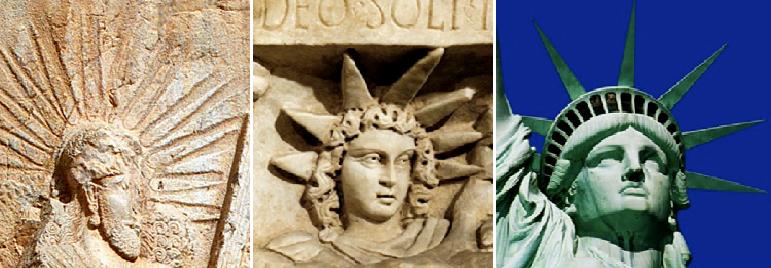
Mithras’ Enduring Legacy? (Left) Mithras at Taghe Bostan, Western Iran; (Middle) Deo Sol Invictus, Italy; (Right) The Statue of Liberty, Staten Island, New York.
Cumont’s large scholarly corpus and his opinions dominated Mithraic studies for decades. A series of conferences on Mithraism beginning in 1970 and an enormous quantity of scholarship by numerous individuals in the last quarter century has demonstrated that many of Cumont’s theories were incorrect (see especially Hinnells 1975 and Beck 1984). At the same time this recent work has greatly increased modern understanding of Mithraism, and it has opened up new areas of inquiry. Many questions, particularly those concerning the origins of the Roman cult of Mithras, are still unresolved and may always remain so. Even so, recent studies such as Mary Boyce’s and Frantz Grenet’s History of Zoroastrianism (1991) approach the relationship between Zoroastrianism and Mithraism in an entirely new light. Iconographic studies, especially those focused on the astrological aspects of the cult, abound, while other scholars examine the philosophical and soteriological nature of the cult (Turcan 1975 and Bianchi 1982). The field of mithraic studies is one which remains active and dynamic and one for which serious attention to the recent work greatly repays the effort to tackle this vast body of exciting new work.
Mithraism as a Modern Religion
As modern scholars have continued to research and rebuild the basics of Mithraism, there has been a corresponding rise of contemporary active Religious interest in the Mithraic Mysteries. In the last two decades the number of people actively aspiring to worship Mithras, (and to become initiated in his Mysteries) has grown exponentially. Mithraism has come from being a forgotten, dead ancient cult remembered only by specialized academics to a path often mentioned among modern Pagans, occultists, reconstructionists and reenactors.
Modern scholarship has made more Mithraic knowledge available to the world than has been available for many centuries. Such information is crucial, yet it is perhaps not the entire reason why the idea of Mithraism as a living path has been gaining popular interest.
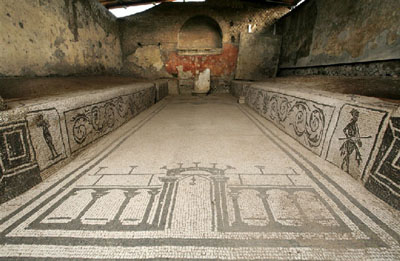
The Mithraeum of Seven Gates, Ostia (Source: Philip Coppens). As noted by Philip Coppens: “The Cult of Mithras, rather than Christianity, almost became the religion that dominated Western Europe. It failed, but intriguingly, we now hardly know anything about it”.
The rediscovery of Mithraism has shown the Mithraic Mysteries to be a religious path amazingly well suited to the modern world. It is an organized, honorable path of Virtue, yet one that accepts and even incorporates other religions. It is a path presided over by a guiding Savior God – but yet one that demands that practitioners learn, grow and become powerful spiritual beings in their own right. It is a path where belief is honored . Yet it is also a path where knowledge and direct experience are considered to be crucial to spiritual understanding.
Mithraism may well become a much-needed bridge between various religions and faiths that exist in the world of today. To those from Christian and other monotheistic backgrounds, Mithraism offers a positive religion of the Light that is presided over by a strong Savior God. To those practicing various Pagan or New Age paths, Mithraism offers organization, systematic knowledge and growth, and a path that historically respects a wide variety of other religious paths and world cultures.
The Future of Mithraism
While the future of Mithraism is of course uncertain, it is still possible to focus on specific facts that are likely to continue. Firstly, it is very unlikely that Mithraism will “slip back into the shadows” to become obscure once again. Mithraic information recovered over the past several decades will continue to be available, and new Mithraic sites, artifacts and inscriptions will continue to be recovered.
It is also likely that a general religious interest in Mithraism will continue to rise. One by one the religions of the ancient world are being reclaimed. It is impossible to say if Mithraism will ever again regain the world position it held during the Roman Empire, it is possible to say that from this point onward there will always be at least a few people who honor Mithras in a religious manner.
Whether organized groups take hold and and organized group Mysteries are rebuilt in the future will be very much determined by what takes place in the present and near future. Mithraeum has been formed to help this possibility become reality.

